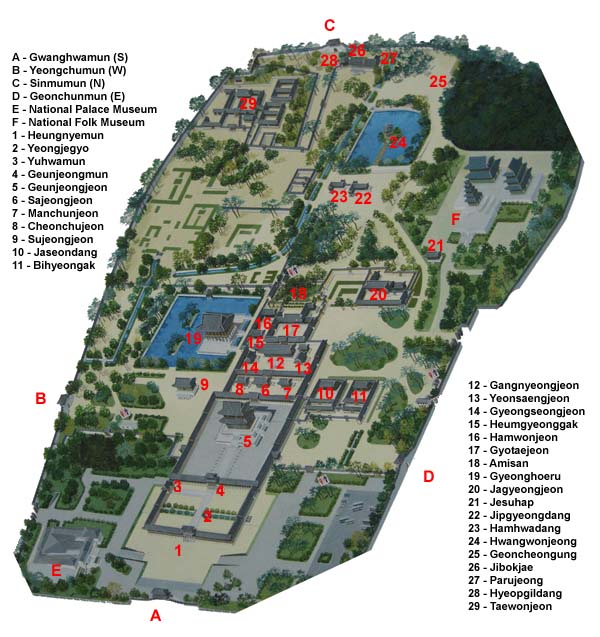 |
| Boyfie and me in Gyeongbokgung Palace |
It was first
constructed in 1395, later burned and abandoned for almost three
centuries, and then reconstructed in 1867. It was the main and largest
palace of the Five Grand Palaces built by the Joseon Dynasty. The name
means "Palace" [Gung] "Greatly Blessed by Heaven" (Gyeongbok). In the
early 20th century, much of the palace was destroyed by Japan. Since
then, the walled palace complex has been gradually restored back to its
original form.
The palace covers a huge area and had many gates, outer courts, inner courts, pavilions, bridges and quarters for the royal family.
 |
| See the Gyeongbokgung Palace map: Really v huge..I din manage to cover all areas also.. |
 |
| Our tour guide explaining using the palace map..but no idea what he's talking dee |
 |
| Entrance to the inner courtyard where the king used to stay and governs the country |
 |
| Boyfie in front of Gyotaejeon |
 |
| Any idea what is this? It's the heater outlet, where the servants have to put in coal to burn and keep the floors warm and cozy for the kings and all the royal family members |
 |
| Gangnyeongjeon is the King's chambers |
In both wings of this building there are
nine rooms arranged in a 3x3 pattern. The central room was where the king slept
and the surrounding eight rooms were where the court ladies kept night watch. Can you give a guess which 8 court ladies plays the most important role? According to our tour guide, the court lady that is in charged of the king's "output" plays the most important role. She has to ensure the king is healthy by ensuring everytime the "output" is nice smell and color too *LOL*
Geunjeongjeon (근정전, the Throne Hall) which is the #5 in the map above, is considered the greatest building of Joseon architecture. And it's also the main building of Gyeongbokgung Palace.
 |
| Geunjeongjeon, the throne hall |
This throne hall is the place where ceremonies of the state, such as new
year's greetings to the king by civil and military officials, were held,
and
where foreign envoys were received. It is believed to be in a very
auspicious location; surrounded by four mountains and with a stream
running
through the grounds.
Now let's look inside the throne hall in detail...
Now let's look inside the throne hall in detail...
 |
| The throne inside the Geunjeongjeon hall |
Behind
the
throne is a picture showing a red sun and a white moon, above
five
mountains, a waterfall and the ocean (the realm) and pine trees (a
sacred tree). This is the symbol of the emperor Interior of
Geunjeongjeon, Gyeongbokgung and it traveled with the him. The sun and
the moon in particular represent all of nature (yang and ying), and the
king and queen, respectively.
 |
| On the ceiling above the Throne Hall, a lifelike dragon painting emphasizes the King's nobility. |
Constructed mainly of wood, Geunjeongjeon sits on the center of a large rectangular courtyard, on top of a two-tiered stone platform. This two-tiered platform is lined with detailed balustrades and is decorated with numerous sculptures depicting imaginary and real animals, such as dragons and phoenixes. The stone-paved courtyard is lined with two rows of rank stones, called pumgyeseoks, indicating where the court officials are to stand according to their ranks. The whole courtyard is fully enclosed by wooden cloisters.
 |
| wanted to have a closer shot of the Geunjeongjeon but the lady's hat is blocking -_-"' |
 |
| 9 guardian animals on the rooftop of Geunjeongjeon Throne Hall |
| This is the roof sculpture of the Beijing Forbidden City Palace |
Well, I am just quoting from the tour guide that the importance of the
building is indicated by the number of guardian angels on top. 9 is the
max number and normally are on the main palace. And these animals are the guardians which protect the palace, and also the royalty who reside within. Btw, there is actually 13 guardian animals instead of 12 like Chinese zodiac animals? Wonder why?
At the edge of the stone steps, you can find dragon, tiger, phoenix and a tortoise.
Next, are all of the animals of the Chinese zodiac, except for the dog and the pig. Here you can see the rat, ox, rabbit, snake, sheep, monkey, horse and tiger.
 |
| Spot the animals? |
Check out this video on Jenny Pope showing you all the guardian animals here:
And if you are up at the throne hall, you can have a nice shot of the Geunjeongmun Gate, which is #4 on the map above.
And if you are up at the throne hall, you can have a nice shot of the Geunjeongmun Gate, which is #4 on the map above.
 |
| Geunjeongmun Gate behind us |
How to get here?
Gyeongbokgung Station (Line 3, Exit 5)
Ganghwamun Station (Line 5, 400m walk from Exit 2)
Website: http://www.royalpalace.go.kr/html/eng/main/main.jsp
Admission Fees
The admission fee for adults (age 19 - 64) is KRW 3,000 (RM 8+), youths (age 7 - 18) is KRW 1,500 (RM 4+) and age 6 or below is free of charge.
Opening Hours:
March-October: 9:00am - 6:00pm
November-February: 9:00am - 5:00pm
Closed every Tuesday.
That's all, hope you enjoy!
*Check here for the summary of my 2012 Korea+Jeju Trip itinerary.

No comments:
Post a Comment